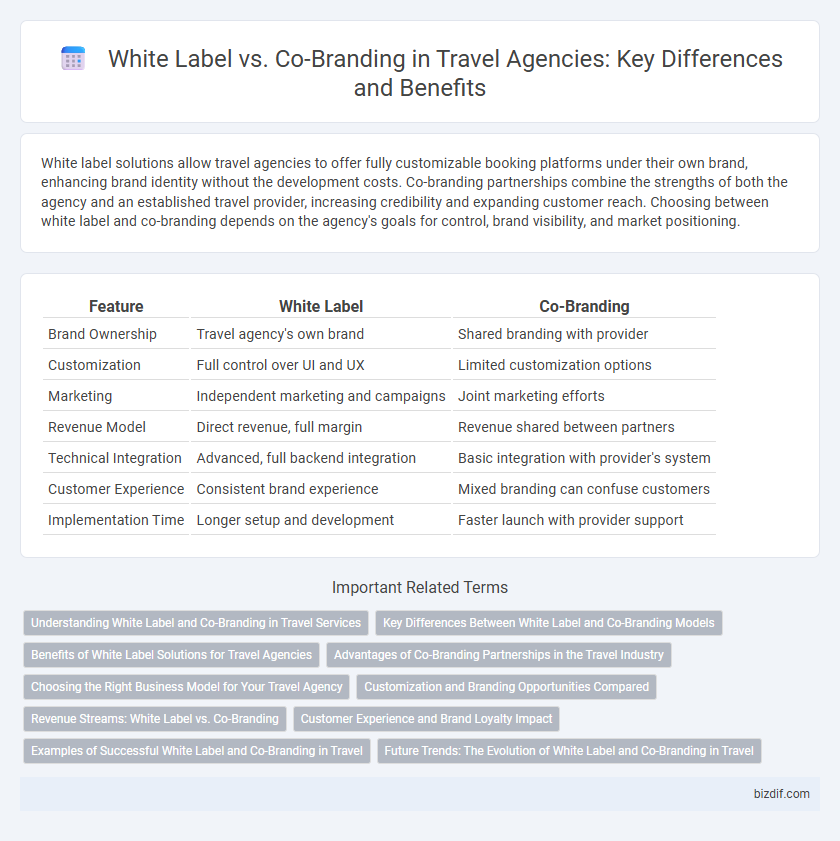White label solutions allow travel agencies to offer fully customizable booking platforms under their own brand, enhancing brand identity without the development costs. Co-branding partnerships combine the strengths of both the agency and an established travel provider, increasing credibility and expanding customer reach. Choosing between white label and co-branding depends on the agency's goals for control, brand visibility, and market positioning.
Table of Comparison
| Feature | White Label | Co-Branding |
|---|---|---|
| Brand Ownership | Travel agency's own brand | Shared branding with provider |
| Customization | Full control over UI and UX | Limited customization options |
| Marketing | Independent marketing and campaigns | Joint marketing efforts |
| Revenue Model | Direct revenue, full margin | Revenue shared between partners |
| Technical Integration | Advanced, full backend integration | Basic integration with provider's system |
| Customer Experience | Consistent brand experience | Mixed branding can confuse customers |
| Implementation Time | Longer setup and development | Faster launch with provider support |
Understanding White Label and Co-Branding in Travel Services
White label travel services enable agencies to offer fully branded travel products and booking platforms developed by third-party providers, allowing seamless integration without showing the original provider's identity. Co-branding in travel involves collaboration between two brands, combining resources and reputations to create a joint offering that leverages both entities' market strengths. Understanding these models helps travel agencies choose between full branding control with white label solutions or shared brand visibility through co-branded partnerships to enhance customer reach.
Key Differences Between White Label and Co-Branding Models
White label travel solutions allow agencies to offer fully branded booking platforms developed by third-party providers, enabling seamless service integration with minimal technical effort. Co-branding involves joint branding efforts where both the travel agency and the service provider share brand visibility, combining reputations to enhance customer trust and marketing reach. White label emphasizes white-label technology and independent brand control, while co-branding prioritizes collaborative branding and shared customer acquisition strategies.
Benefits of White Label Solutions for Travel Agencies
White label solutions enable travel agencies to offer customized booking platforms without extensive development costs, enhancing brand identity and customer loyalty. These platforms provide seamless integration with global distribution systems (GDS), allowing access to a wide range of flights, hotels, and tours under the agency's brand. By leveraging white label technology, agencies can increase profit margins through direct sales while maintaining control over customer data and marketing strategies.
Advantages of Co-Branding Partnerships in the Travel Industry
Co-branding partnerships in the travel industry enhance brand visibility by combining the strengths of two established companies, creating a trusted travel experience for customers. These collaborations enable access to broader customer bases and diversified marketing channels, increasing sales potential and customer engagement. Leveraging co-branding also allows travel agencies to offer exclusive promotions and customized travel packages, driving customer loyalty and differentiation in a competitive market.
Choosing the Right Business Model for Your Travel Agency
Selecting the ideal business model for your travel agency hinges on whether you prioritize brand control or market reach. White label solutions enable exclusive branding and seamless integration, allowing your agency to present customized travel services as your own. Co-branding partnerships expand audience access and leverage shared reputations, fostering collaborative growth but requiring clear brand alignment and shared responsibilities.
Customization and Branding Opportunities Compared
White label travel solutions offer extensive customization options, allowing agencies to fully tailor the user interface, logos, and branding elements to match their unique identity, enhancing brand consistency across customer touchpoints. In contrast, co-branding partnerships blend the branding of both the travel agency and supplier, providing joint promotional opportunities but limiting the degree of personalized customization. Agencies seeking full control over brand presentation typically favor white label models, while those aiming to leverage brand recognition of established partners opt for co-branding strategies.
Revenue Streams: White Label vs. Co-Branding
White label travel solutions generate steady revenue streams through commission-based sales and subscription fees by allowing agencies to resell services under their own brand, enhancing control over pricing and customer experience. Co-branding leverages partnerships between travel agencies and service providers, creating diversified income via shared profits, joint marketing efforts, and access to exclusive deals that attract a broader customer base. Both models drive revenue growth, with white labeling focusing on brand autonomy while co-branding maximizes collaborative marketing and resource pooling.
Customer Experience and Brand Loyalty Impact
White label travel services offer seamless integration under a single brand, enhancing customer experience through consistent branding and streamlined booking processes. Co-branding leverages the strengths of two brands, fostering increased trust and loyalty by offering unique, combined value propositions to travelers. Both strategies impact brand loyalty differently: white label builds deeper connection with a single brand identity, while co-branding cultivates broader appeal through partnership recognition.
Examples of Successful White Label and Co-Branding in Travel
Expedia's White Label partnerships with airlines such as Qatar Airways enable seamless booking platforms under airline branding, boosting customer loyalty. Co-branding efforts between American Express and Hilton Honors deliver enhanced travel rewards, blending financial services with hospitality benefits. These examples showcase strategic collaborations that leverage brand strengths to expand market reach in the travel industry.
Future Trends: The Evolution of White Label and Co-Branding in Travel
White label solutions in travel are increasingly integrating AI-driven personalization to enhance customer experiences, while co-branding partnerships leverage shared data analytics to target niche markets more effectively. Emerging technologies like blockchain are facilitating transparent and secure transactions in both white label and co-branded platforms, driving consumer trust and loyalty. The future of travel distribution relies on seamless interoperability between white label platforms and co-branded applications, enabling dynamic packaging and real-time inventory management.
White label vs Co-branding Infographic

 bizdif.com
bizdif.com